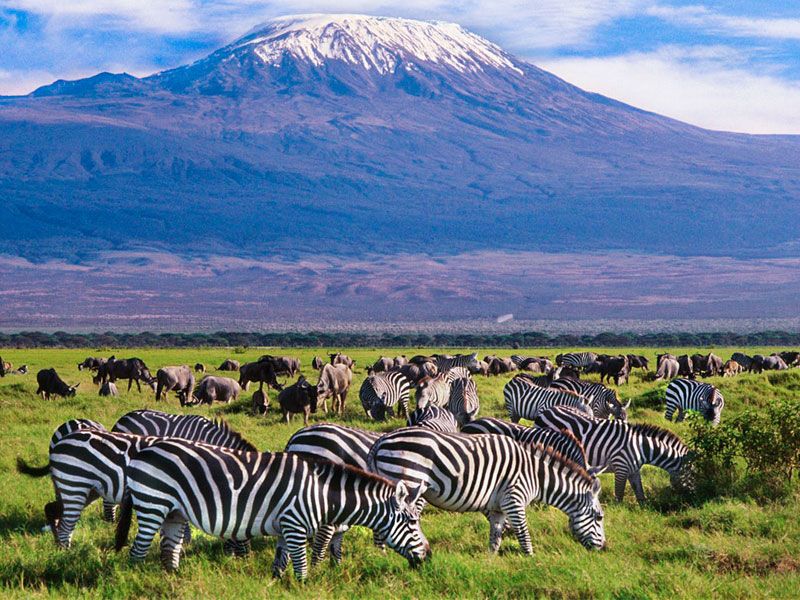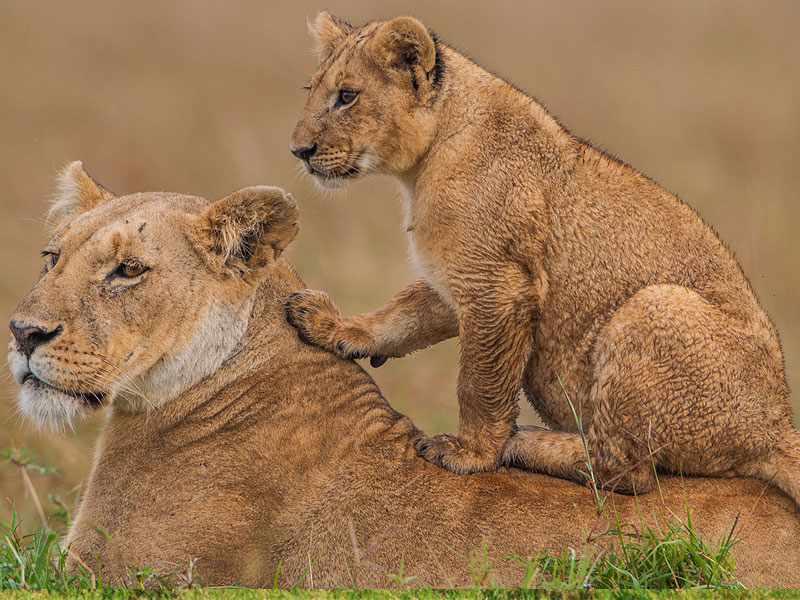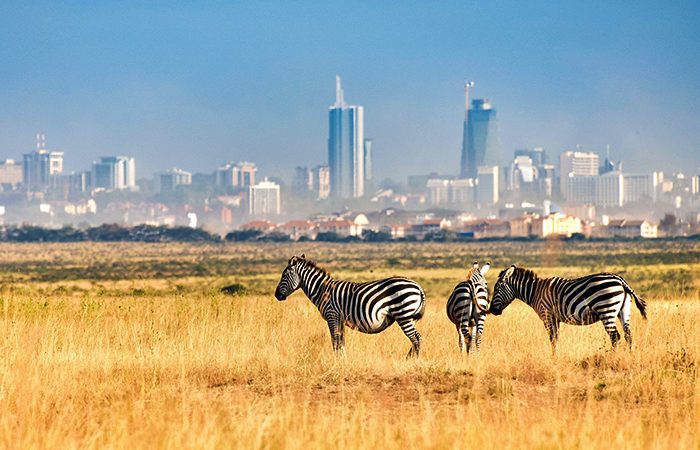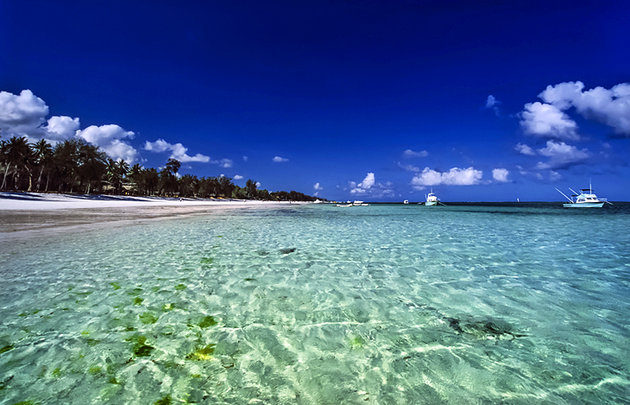Amboseli National Reserve
Crowned by Mount Kilimanjaro, Africa’s highest peak, Amboseli National Reserve is one of Kenya’s most popular tourist parks. The name “Amboseli” comes from a Maasai word meaning “salty dust”, an apt description for the park’s parched conditions. The reserve is one of the best places in Africa to view large herds of elephants up close. Other wildlife commonly spotted in the park includes big cats such as lion and cheetah as well as giraffe, impala, eland, waterbuck, gazelle, and more than 600 species of birds. Nature lovers can explore five different habitats here ranging from the dried-up bed of Lake Amboseli, wetlands with sulfur springs, savannah, and woodlands. Look for the local Maasai people who live in the area around the park.
Loitokitok District, Rift Valley

Maasai Mara National Reserve
Maasai Mara is one of the world’s most magnificent game reserves. Bordering Tanzania, the Mara is the northern extension of the Serengeti and forms a wildlife corridor between the two countries. It’s named after the statuesque, red-cloaked Maasai people who live in the park and graze their animals here as they have done for centuries. In their language, Mara means “mottled”, perhaps a reference to the play of light and shadow from the acacia trees and cloud-studded skies on the vast grasslands. The park is famous for the Great Migration when thousands of wildebeest, zebra, and Thomson’s gazelle travel to and from the Serengeti, from July through October. In the Mara River, throngs of hippos and crocodiles lurk. The park is also known for providing excellent predator sightings thanks to its relatively large populations of lion, cheetah, and leopard – especially in the dry months from December through February. Thanks to the park’s altitude, the weather here is mild and gentle year-round.
Location: Narok County

Tsavo National Park
Kenya’s largest park, Tsavo, is sliced in two; Tsavo West and Tsavo East. Together these parks comprise four percent of the country’s total area and encompass rivers, waterfalls, savannah, volcanic hills, a massive lava-rock plateau, and an impressive diversity of wildlife. Midway between Nairobi and Mombasa, Tsavo East is famous for photo-worthy sightings of large elephant herds rolling and bathing in red dust. The palm-fringed Galana River twists through the park providing excellent game viewing and a lush counterpoint to the arid plains. Other highlights here include the Yatta Plateau, the world’s longest lava flow, Mudanda Rock, and the Lugard Falls, which spill into rapids and crocodile-filled pools. Tsavo West is wetter and topographically more varied with some of the most beautiful scenery in the northern reaches of the park. Highlights here are Mzima Springs, a series of natural springs with large populations of hippos and crocodiles, Chaimu Crater, a great spot for spotting birds of prey, and Ngulia Rhino Sanctuary. Wildlife is not as easy to see in Tsavo West because of the denser vegetation, but the beautiful scenery more than compensates.
120 km northeast of Mombasa

Samburu, Buffalo Springs, and Shaba National Reserves
On the banks of the palm-lined Ewaso Nyiro River, Samburu, Buffalo Springs, and Shaba Reserves lie in an arid region in the remote north of Kenya. Shaba National Reserve is one of two areas where George and Joy Adamson raised Elsa the lioness, made famous in the film “Born Free”. The wildlife in all three reserves depends on the waters of the river to survive, and many species are specially adapted to the parched conditions such as Grevy’s zebras, Somali ostriches, and gerenuks, the long-necked antelope that stand on two rear legs to reach the fresh shoots on upper tree limbs. A top attraction in Samburu National Reserve is the Sarara Singing Wells, local watering holes where Samburu warriors sing traditional songs while hauling water for their cattle to drink. Tourists here may also be rewarded with sightings of big cats and wild dogs.
Northern Kenya

Lake Nakuru National Park
Lake Nakuru National Park, in Central Kenya, is famous for its huge flocks of pink flamingoes. The birds throng on Lake Nakuru itself, one of the Rift Valley soda lakes that comprises almost a third of the park’s area. The park was established in 1961 and more than 450 species of birds have been recorded here as well as a rich diversity of other wildlife. Lions, leopards, warthogs, waterbucks, pythons, and white rhinos are just some of the animals visitors might see, and the landscapes range from sweeping grasslands bordering the lake to rocky cliffs and woodland. The park also protects the largest euphorbia candelabrum forest in Africa. These tall branching succulents are endemic to the region and provide an interesting textural element to the arid landscapes.
Central Kenya

Lamu
The small island of Lamu, northeast of Mombasa, oozes old-world charm. A UNESCO World Heritage Site, Lamu Old Town is Kenya’s oldest continually inhabited settlement with origins dating back to the 12th century. Strolling the labyrinthine streets, visitors will see the island’s rich trading history reflected in the buildings. Architectural features from the Arab world, Europe, and India are evident, yet with a discernible Swahili technique. Intricately carved wooden doors, coral stone buildings, hidden courtyards, verandas, and rooftop patios are common features. Visiting here is like stepping back in time. Dhows plow the harbor, few if any motorized vehicles exist here, and donkeys still rule the streets as they have done for centuries. Most of Lamu’s population is Muslim and both men and women dress in traditional attire. Top attractions on the island include Lamu Museum, with displays on Swahili culture and the region’s nautical history; Lamu Fort; and the Donkey Sanctuary. If all the history is a little too much, visitors can bask on one of the island’s white-sand beaches or sip Arabic coffee in a local café.
341 km northeast of Mombasa

Lake Naivasha
A haven for birders, Lake Naivasha lies at the highest point of the Great Rift Valley and has been known to shrink considerably in times of extreme drought. A flourishing floriculture industry in the area is also impacting water levels and quality. One of the best ways to view the wildlife is by boat. More than 400 species of birds have been spotted here, including African fish eagles. Hippos slosh in the water, and giraffes, zebra, buffalo, and eland graze around the edges of the lake. Keep a lookout for colobus monkeys in the canopies too. Near Lake Naivasha, the Crater Lake Game Sanctuary features a wildlife-rich nature trail. Just south of Lake Naivasha, the relatively affordable Hell’s Gate National Park protects a wide variety of wildlife and offers excellent climbing opportunities with two extinct volcanoes and the red cliffs of Hell’s Gate Gorge. On the southern shore of Lake Naivasha, visitors can pop in for a cup of tea at the Elsamere Conservation Centre, the former home of the late Joy Adamson, author of “Born Free”, and her husband George.
Rift Valley Province

Nairobi City
Tourists can explore the city’s famous historic sites as well as some excellent wildlife-related attractions. The Nairobi National Museum is a great one-stop spot to see exhibits on Kenya’s history, nature, culture, and contemporary art. Green thumbs will also enjoy the botanic gardens on the grounds. Another popular tourist attraction is the Karen Blixen Museum, the restored residence of the famous Danish author of the book, “Out of Africa”, also known by her pen name, Isak Dinesen. To see wildlife without venturing far from the city center, visit Nairobi National Park, now a black rhino sanctuary and also home to a host of other classic safari stars including lions, leopards, buffalo, zebras, wildebeest, and cheetahs. Within the park’s borders, the David Sheldrick Wildlife Trust offers close-up encounters with elephant orphans. And no visit to Nairobi would be complete without popping into the Giraffe Centre near the famous Giraffe Manor where these long-necked beauties eat out of visitors’ hands. While visiting Nairobi, travelers should exercise care as crime rates have escalated in recent years.
South-central Kenya

Malindi
North of Mombasa on the Kenyan coast, Malindi is a beach resort popular with European visitors. Thanks to its rich trading history, it too is a melting pot of cultures and cuisines and also sports a split personality. The part historic old town, a part modern tourist hub, Malindi is where travelers come to the sun on the white sands of Watamu Beach, dive the coral reefs of the Malindi and Watamu Marine National Parks, and soak up a dose of Swahili history in the historic town, dating from the 12th century. Here tourists can visit the Jami Mosque, two pillar tombs from the 14th century, and the Church of St Francis Xavier, one of East Africa’s oldest churches. On the promontory, the Vasco De Gama Cross is one of the oldest standing monuments in Africa. In the former home of an Indian trader, the Malindi Museum has displays on Vasco de Gama and also doubles as an information center. Another popular tourist attraction is the Falconry of Kenya, a rehabilitation center for sick and injured birds. About 30 km northeast of Malindi, the Marafa Depression, also called Hell’s Kitchen or Nyali is a set of sandstone gorges sculpted by the wind and rain.
120 km northeast of Mombasa

Mount Kenya National Park
In the Central Highlands, east of the Great Rift Valley, Mount Kenya National Park is a UNESCO World Heritage Site encompassing the country’s namesake highest mountain at 5,199 m and providing the rare sight of equatorial snow.
175 km northeast of Nairobi


